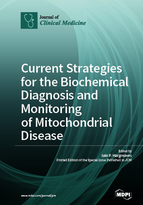Current Strategies for the Biochemical Diagnosis and Monitoring of Mitochondrial Disease
A special issue of Journal of Clinical Medicine (ISSN 2077-0383). This special issue belongs to the section "Immunology".
Deadline for manuscript submissions: closed (30 June 2017) | Viewed by 142137
Special Issue Editor
Interests: mitochondrial metabolism; coenzyme Q10; oxidative stress; antioxidants
Special Issues, Collections and Topics in MDPI journals
Special Issue Information
Dear Colleagues,
Mitochondrial disease constitutes a complex and heterogeneous group of disorders resulting from a defect in mitochondrial respiratory chain (MRC) enzyme activity. In view of the dual regulation of the MRC, exercised by both the mitochondrial and nuclear genome, mutations in either mitochondrial or nuclear DNA can result in a MRC deficiency. Whilst a single organ can be affected, MRC disorders often result in a multi-organ system presentation with prominent neurological and myopathic features. The diagnosis of MRC disorders can be complex, and requires a coordinated interplay of a number of disciplines. However, biochemical determination of metabolities in blood, CSF and/or urine are generally considered to be first-line investigations for the diagnosis of these disorders, although they lack sensitivity and specificity. Furthermore, there is a lack of consensus on the overall utility of monitoring other biochemical parameters, which may be of diagnostic value. For example, although oxidative stress may contribute to the pathogenesis of mitochondrial disorders, few centres monitor this as part of their diagnostic repertoire. Therefore, the purpose of this Special Issue will be to highlight potential biomarkers of mitochondrial disease and to discuss the appropriateness of biochemical markers to monitor disease progression and therapeutic intervention.
Dr. Iain P. Hargreaves
Guest Editor
Manuscript Submission Information
Manuscripts should be submitted online at www.mdpi.com by registering and logging in to this website. Once you are registered, click here to go to the submission form. Manuscripts can be submitted until the deadline. All submissions that pass pre-check are peer-reviewed. Accepted papers will be published continuously in the journal (as soon as accepted) and will be listed together on the special issue website. Research articles, review articles as well as short communications are invited. For planned papers, a title and short abstract (about 100 words) can be sent to the Editorial Office for announcement on this website.
Submitted manuscripts should not have been published previously, nor be under consideration for publication elsewhere (except conference proceedings papers). All manuscripts are thoroughly refereed through a single-blind peer-review process. A guide for authors and other relevant information for submission of manuscripts is available on the Instructions for Authors page. Journal of Clinical Medicine is an international peer-reviewed open access semimonthly journal published by MDPI.
Please visit the Instructions for Authors page before submitting a manuscript. The Article Processing Charge (APC) for publication in this open access journal is 2600 CHF (Swiss Francs). Submitted papers should be well formatted and use good English. Authors may use MDPI's English editing service prior to publication or during author revisions.
Keywords
- mitochondrial respiratory chain (MRC)
- mitochondrial disorders
- diagnosis
- biochemical parameters/markers
- oxidative stress
- biomarkers







